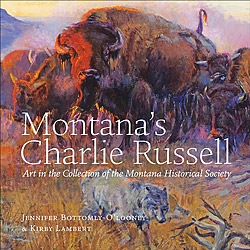
In June 1915, Nancy Russell wrote Wall Street financier Malcolm S. Mackay regarding his purchase of her husband’s recently completed oil painting, “When Horses Talk War There’s Slim Chance for Truce.”
In her letter, she asked Mackay, “Do you know that you have as good a collection of pictures, or if anything, better, than we have? And a lot finer than any other person.”
Since 1952 this outstanding group of Charlie’s “pic-tures” – 43 oils, watercolors, bronzes, and pen-and-ink sketches – has formed the nucleus of the Montana Historical Society’s unmatched assemblage of the famed cowboy artist’s paintings, illustrated letters, sketches and sculpture.
It’s long been the dream of many at the Historical Society to reproduce its entire Russell art collection in a high-quality book that would celebrate the artist’s vision of Montana and the breadth of his amazing career – a trajectory that took him from cowboying in the Judith Gap to being one of the best-loved artists of the West.
That dream finally came to fruition with a new book by the MHS Press, Montana’s Charlie Russell: Art in the Collection of the Montana Historical Society.
The handsome hardcover book, authored by MHS staffers Jennifer Bottomly-O’looney and Kirby Lambert, features high-resolution reproductions of all 230 Russell artworks in the MHS collection.
According to Lambert, the society has one of the largest, and highest quality collections of Russell’s work in the nation. Mackay, who was a friend of the artist, “just had really good taste, and was a pretty demanding patron.”
According to Lambert, who has been working on the project for the past four years, “the whole thing has been really exciting.”
The book offers a succinct way for the Society “to share why Russell is still important, why he still speaks to, and for, Montanans.”
Lambert, who grew up in Texas, says he knew little about Montana’s famed cowboy artist when he joined the historical society 30 years ago. “Over the years, I’ve worked on various exhibits and topics. Often, by the time you’re done, you’re tired of it,” he says. “I never got tired of Russell.”
The reasons are wrapped around the artist’s talent and personality. “He’s a great artist, a remarkable storyteller,” says Lambert. “He was extremely prolific and had a great sense of humor.”
In addition to making the collection available to a broader audience, Lambert hopes the book helps convey the personality and charisma of the man who made more than 2,000 paintings in his lifetime. The book also chronicles the progression of his career from his arrival in Montana in 1880, when open-range ranching was at its peak, until his death in 1926.
“There’s nothing better than his letters for getting a sense of who he was,” says Lambert. “He didn’t like to write letters, so they were pretty short … He couldn’t spell, and he had really bad handwriting. But they’re so colorful.”
Researching the book also gave Lambert an opportunity to read through the business correspondence written by the artist’s wife, Nancy. “It gave me a greater appreciation for how important she was,” he said.
The 418-page book also includes images of artifacts from the archives, like Russell’s beat-up cowboy hat, his spurs and branding iron, and photographs of the artist, his favorite horses, his wife, and many of their friends.
It tells the stories behind each of Russell’s artworks in the collection, drawing on information from Russell experts across the nation. Even devoted Russell fans are sure to find “several surprises,” says Lambert.
For example, Russell’s series of “Keeoma” paintings, which depict a sensual Native woman reclining in a tipi, were rumored to be paintings of an Indian woman he had once loved. But the book dispels that notion with a photograph of his wife posing for the painting.
Historian K. Ross Toole, who was director of the Society in 1952, said while raising funds to acquire the Mackay collection: “If Montana has contributed one thing to the heritage of the whole West, it is Charles M. Russell’s paintings … It was Montana that inspired him; it was Montana that he painted.”
The hardcover book is 12-by-12 inches, and sells for $80. Visit mhs.mt.gov for more information.